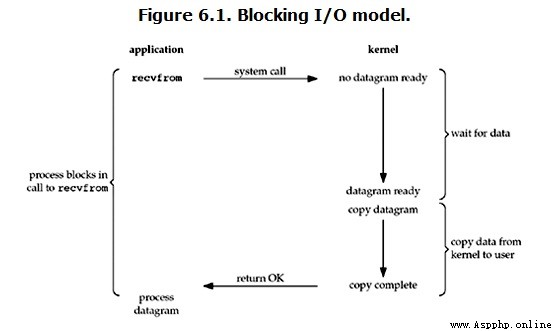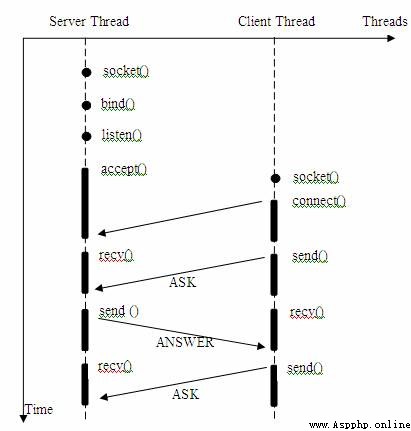The duration of this section needs to be controlled 15 Within minutes
stay linux in , By default, all socket All are blocking, A typical read operation flow is like this :

When the user process calls recvfrom This system call ,kernel He began IO The first stage of : Prepare the data . about network io Come on , Many times the data hasn't arrived at the beginning ( such as , I haven't received a complete UDP package ), This is the time kernel Just wait for enough data to come .
On the user process side , The whole process will be blocked . When kernel Wait until the data is ready , It will take data from kernel Copy to user memory ,
then kernel Return results , The user process is released block The state of , Run it again .
therefore ,blocking IO It is characterized by IO Two stages of implementation ( Waiting for data and copying data ) All be block 了 .
Almost all network programming that programmers first come into contact with comes from listen\(\)、send\(\)、recv\(\) Wait for the interface to start ,
Using these interfaces makes it easy to build servers / The model of the client . But most of them socket Interfaces are all blocking . Here's the picture
ps:
A blocking interface is a system call ( It's usually IO Interface ) Do not return the call result and keep the current thread blocked
Only when the system call gets the result or the timeout error returns .

actually , Unless otherwise specified , Almost all IO Interface ( Include socket Interface ) It's all blocking . This brings a big problem to network programming , As in the call recv(1024) At the same time , Threads will be blocked , in the meantime , Threads will not be able to perform any operations or respond to any network requests .
A simple solution :
Use multithreading on the server side ( Or multiple processes ). Multithreading ( Or multiple processes ) The goal is to have separate threads for each connection ( Or the process ),
In this way, the blocking of any connection will not affect other connections .
The problem with the scheme is :
The way to start multiple processes or threads , In response to hundreds of connection requests at the same time , No matter multithreading or multiprocessing, it will occupy system resources seriously ,
Reduce the response efficiency of the system to the outside world , And threads and processes themselves are more likely to enter the pseudo dead state .
The improved scheme :
Many programmers may consider using “ Thread pool ” or “ Connection pool ”.“ Thread pool ” Designed to reduce the frequency of thread creation and destruction ,
It maintains a reasonable number of threads , And let the idle thread assume the new execution task again .“ Connection pool ” Maintain the connected cache pool , Try to reuse existing connections 、
Reduce the frequency of creating and closing connections . Both of these technologies can reduce the system overhead very well , Are widely used in many large systems , Such as websphere、tomcat And various databases .
There are also problems in the improved scheme :
“ Thread pool ” and “ Connection pool ” Technology only alleviates frequent calls to a certain extent IO The resource occupation brought by the interface . and , So-called “ pool ” There is always a ceiling ,
When the request is well over the upper limit ,“ pool ” The response of the constructed system to the outside world is not much better than when there is no pool . So use “ pool ” The scale of the response it faces... Has to be considered ,
And adjust according to the response scale “ pool ” Size .
Corresponding to the possible simultaneous tens or even tens of thousands of client requests in the above example ,“ Thread pool ” or “ Connection pool ” Maybe it can relieve some of the pressure , But it doesn't solve all the problems . All in all , Multithreading model can solve small-scale service request conveniently and efficiently , But in the face of large-scale service requests , The multithreading model also has bottlenecks , You can try to solve this problem with a non blocking interface .
 How to modify the horizontal and vertical axis scales of python line charts?
How to modify the horizontal and vertical axis scales of python line charts?
p1 is the current effectp2 is
 Python - matplot plot plot multi graph histogram and line graph coexist and share the X axis
Python - matplot plot plot multi graph histogram and line graph coexist and share the X axis
introduction Previous article
 Python playful data 6 - the difference between numpy ndarray array and python list
Python playful data 6 - the difference between numpy ndarray array and python list
introduction The first two ar